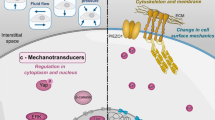Abstract
It is a common belief that chondrocyte death must precede calcification in the growth plate. To challenge this dogma, cell devitalization was induced in anin vitro model that mimicsin situ cartilage calcification. Chick limb-bud mesenchymal cells, plated in micromass culture, differentiate to form a cartilaginous matrix which mineralizes in the presence of inorganic or organic phosphate. The mineral formed resembles physiologic mineral in crystal size, composition, and distribution. Killing cells by water lysis, ethanol fixation, freeze-thawing, trypsinization, or impairing their function by oligomycin treatment prior to the time at which mineralization commenced, prevented mineral deposition. In contrast, devitalizing cells by any of these techniques after mineralization commenced resulted in dystrophic calcification (excessive, randomly distributed mineral of larger than physiologic crystal size). Based on analyses of45Ca uptake, FT-IR microscopy, X-ray diffraction, and transmission electron microscopy, it is concluded that the presence of viable cells is obligatory for physiologic cartilage calcification in the differentiating chick limb-bud mesenchymal cell culture system.
Similar content being viewed by others
References
Brighton CT, Heppenstall RB (1971) Oxygen tension in zones of the epiphyseal plate, the metaphysis and diaphysis. J Bone Jt Surg 53A:719–728
Matsumoto H, DeBolt K, Shapiro IM (1982) Adenine, guanine, and inosine nucleotides of chick growth cartilage: relationship between energy status and the mineralization process. J Bone Miner Res 3:347–352
Cruess RL (1982) The musculoskeletal system: embryology, biochemistry and physiology. Churchill Livingston, NY, p 197
Gamble JG (1988) The musculoskeletal system: physiological basics. Raven Press, New York
Boskey AL, Stiner D, Doty S, Binderman I (1991) Requirement of vitamin C for cartilage calcification in a differentiating chick limb-bud mesenchymal cell culture. Bone 12:277–282
Boskey AL, Pleshko N, Binderman I, Mendelsohn R (1992) Mineralization during in vitro calcification: an FT-IR microscopic investigation. Calcif Tissue Int 51:443–448
Boskey AL, Doty SB, Binderman I, Leboy P (1993) Insight into the effect of β-glycerophosphate on in vitro mineralization. 39th Annual Meeting, Orthopaedic Research Society, Feb 15–18
Boskey AL, Doty SB, Binderman I (1994) ATP promotes mineralization in differentiating chick limb-bud mesenchymal cell cultures. Microsc Res Technique 28:492–504
Boskey AL, Stiner D, Leboy P, Doty S, Binderman I (1992) Optimal conditions for cartilage calcification in differentiating chick limb-bud mesenchymal cells. Bone Miner 16:11–36
Hamburger V, Hamilton HL (1951) A series of normal stages in the development of the chick embryo. J Morphol 88:49–92
Ahrens PBA, Solursh M, Reiter RS (1977) Stage-related capacity for limb chondrogenesis in cell culture. Dev Biol 60:69–82
Kim YJ, Sah RJY, Doong JYH, Grodzinsky AJ (1988) Fluorometric assay of DNA in cartilage explants using Hoechst 33258. Anal Biochem 174:158–165
Meloan SN, Puchtler H (1985) Chemical mechanisms of staining methods: von Kossa's technique. What von Kossa really wrote and a modified reaction for selective demonstration of inorganic phosphates. J Histotech 8:11–13
Fallon MD, Whyte MP, Teitelbaum SL (1980) Stereospecific inhibition of alkaline phosphatase by L-tetramisole prevents in vitro cartilage calcification. Lab Invest 43:489–494
Roach HJ (1992) Trans-differentiation of hypertrophic chondrocytes into cells capable of producing a mineralized bone matrix. Bone Miner 19:1–20
Paulsen D, Solursh M (1988) Microtiter micromass cultures of limb-bud mesenchymal cells. In Vitro Cell Dev Biol 24:138–147
Tuan RS (1991) Ionic regulation of chondrogenesis In: Cartilage: molecular aspects. Hall BK Newman SA (eds) CRC Press, Boca Raton, FL
Janners MY, Searls RL (1970) Changes in the rate of cellular proliferation during the differentiation of cartilage and muscle in the mesenchyme of the embryonic chick wing. Dev Biol 23:136–165
Boskey AL, Ziecheck W, Guidon P, Doty SB (1993) Gallium nitrate inhibits alkaline phosphatase activity in differentiating mesenchymal cell cultures. Bone Miner 20:179–192
Hunziger EB, Schenk RK, Cruz-Orvive L-M (1987) Quantitation of chondrocyte performace in growth-plate cartilage during longitudinal bone growth. J Bone Jt Surg 69A:162–173
Lee NH, Shapiro IM (1974) Oxidative phosphorylation by chondrocyte mitochondria. Calcif Tissue Res 16:277–282
Shapiro IM, Boyde A (1984) Microdissection—elemental analysis of the mineralizing growth cartilage of the normal and rachitic rat. Metab Bone Dis Rel Res 5:317–326
Bellows CG, Aubin JE, Heersche JNM, Antosz ME (1986) Mineralized bone nodules formed in vitro from enzymatically released rat calvarial cell populations. Calcif Tissue Int 38:143–154
Gerstenfeld LC, Chipman SD, Glowacki J, Lian JB (1987) Expression of differentiated function by mineralizing cultures of chicken osteoblasts. Dev Biol 122:49–60
Tacchetti C, Quarto R, Campanile G, Cancedda R (1989) Calcification of in vitro developed hypertrophic cartilage. Dev Biol 132:442–447
Dunstone JR (1959) Ion-exchange reactions between cartilage and various cations. Biochem J 77:164–170
Ralis ZA (1991) Structural and cellular reactions of bone tissue to orthopaedic implants. Interfaces medicine and mechanics 2. Williams KR, Toni A, Middleton J, Palloti G (eds) Elsevier, Applied Science, London, pp 204–225
Author information
Authors and Affiliations
Rights and permissions
About this article
Cite this article
Boskey, A.L., Doty, S.B., Stiner, D. et al. Viable cells are a requirement forIn vitro cartilage calcification. Calcif Tissue Int 58, 177–185 (1996). https://doi.org/10.1007/BF02526884
Received:
Accepted:
Issue Date:
DOI: https://doi.org/10.1007/BF02526884




